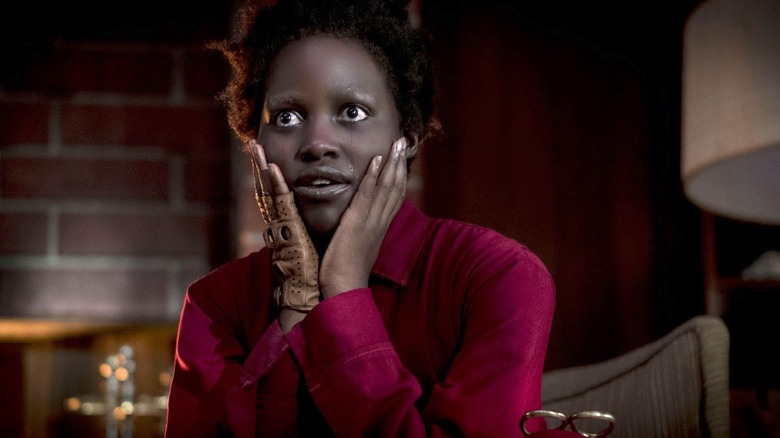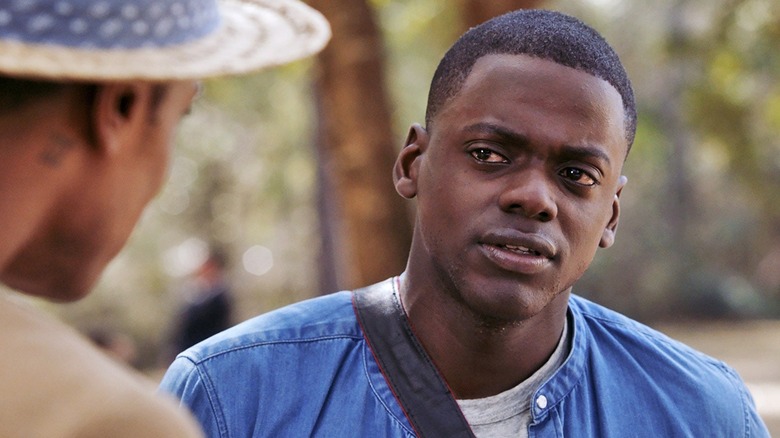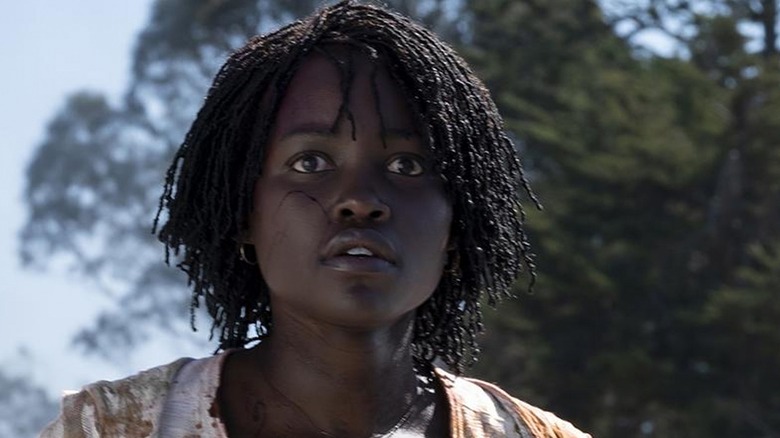Netflix's Top Charts Are Seeing Double Jordan Peele
With his 2017 directorial debut "Get Out," Jordan Peele firmly established himself as a horror filmmaker to watch. It was a box office sensation, making Peele a household name for more than his comedy. Viewers might have shown up expecting something in the vein of his sketch comedy work, anticipating a darker story out of the legendary run of "Key and Peele," in which he performed with Keegan-Michael Key. But "Get Out," while often darkly comedic in its skewering of a supposed "post-race" America, was an all-out horror movie, and was made with such brilliant technique and crackling tension that whatever Peele did next would have an audience. And this time, they'd be ready for the horror.
That follow-up was 2019's "Us." Altogether weirder, more sprawling, and more ambitious than his previous movie, "Us" follows a family on a vacation that goes violently wrong when an underground civilization of doppelgangers rises out of their subterranean abode to kill their earthly selves. Where "Get Out" took a "Guess Who's Coming To Dinner" premise to its most extreme, "Us" blended a hodgepodge of '70s and '80s horror movies for its saga of a family torn apart by themselves.
Even with just three features under his belt (2022's spectacular "Nope" is his biggest production yet), Peele has become an event filmmaker. He's a director who takes premises out of nightmares and fuses them with a variety of cinematic influences to make movies unlike anything else coming out. Because of that, it makes sense that both "Get Out" and "Us" have risen to the top 10 of the Netflix charts per FlixPatrol. While Peele's movies play best to packed theaters, they also work great on their own: funny, imaginative, and extremely creepy.
Get Out of the Sunken Place
For such a confident and accomplished directorial debut, "Get Out" might end up being an outlier in the Jordan Peele filmography. For one thing, it stands as one of a handful of horror movies that have been awarded at the Oscars, up there with "Silence of the Lambs" and "The Exorcist." For another, it's a movie with an incredibly tight, clockwork script, where every piece of the plot has a direct setup and payoff, and the audience becomes conscious of the plot twists at just the right time to scream, well, "Get out!"
Chris (Daniel Kaluuya) is a young Black photographer visiting the family of his affluent white girlfriend Rose Armitage (Allison Williams) for the first time. Chris immediately susses out that something is wrong in the Armitage household, something hidden beneath the family's old money veneer and claims, again and again, how not-racist they are. For as much as neurosurgeon father Dean (Bradley Whitford) claims he "would have voted for Obama for a third term," their community's relationship to Black people is shockingly fetishistic.
They're so not-racist, in fact, that they have designed a scheme wherein the Black bodies accepted into the community are ultimately taken over by wealthy white people. Dean uses his neuroscience expertise to effectively transplant the brains of the highest bidder into the bodies of the Black people his daughter brings home.
"Get Out" paces its reveals perfectly, unnerving viewers before ultimately trapping them along with Chris into the "Sunken Place," a psychological void in which the family's victims are helpless to protect themselves. The ultimate secret to the success of "Get Out"? Its hard-earned happy ending, which almost didn't happen.
The doppelganger horror of Us
Jordan Peele's other movies might not have received the awards and prestige of "Get Out," and they might have drifted from that movie's excellent structure for something more unexplainable and nightmarish. But they also show his growth as a filmmaker, with an ability to create images and scenes that feel inexplicable and totally unique. Once you've seen "Us," you can't forget the red jumpsuits, the scissors, and even the characters' shadows as they walk along the beach. And for all the movie's self-conscious third-act exposition, there are still so many questions, so much that remains beyond the explanations. Peele drew from a classic "Twilight Zone" episode for "Us," but more importantly, he made a movie that seemed to blend aspects of "Jaws," "The Shining," and "Poltergeist" to tell his story of a family's fight against their shadow selves.
Adelaide Wilson (Lupita Nyong'o) is just one target of the violence of what Peele called "the Tethered," an underground society of nonverbal, scissor-wielding doppelgangers with a vision. Their origin is explained in great detail, but their existence goes beyond any real explanation. Why does Adelaide's Tethered (named Red) possess the ability to speak? The movie's answer for that might be easily discernible to anybody paying attention, but it doesn't make the character any less tragic, even as she leads the Tethered to spread their population across America, killing their original forms and holding hands.
The consequent social commentary arguably lacked the sharpness of "Get Out," and audiences and critics alike struggled with the metaphor at the movie's center. But as a nightmarish ride through a terrible vacation, it succeeds in what Peele had set out to do: make a full-on horror movie.


